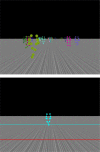Visual perception of travel distance for self-motion through crowds
- PMID: 37099279
- PMCID: PMC10148655
- DOI: 10.1167/jov.23.4.7
Visual perception of travel distance for self-motion through crowds
Abstract
Humans can use visual motion to estimate the distance they have traveled. In static environments, optic flow generated by self-motion provides a pattern of expanding motion that is used for the estimation of travel distance. When the environment is populated by other people, their biological motion destroys the one-to-on correspondence between optic flow and travel distance. We investigated how observers estimate travel distance in a crowded environment. In three conditions, we simulated self-motion through a crowd of standing, approaching, or leading point-light walkers. For a standing crowd, optic flow is a veridical signal for distance perception. For an approaching crowd, the visual motion is the sum of the self-motion-induced optic flow and the optic flow produced by the approaching walkers. If only optic flow were to be used, travel distance estimates would be too high because of the approaching direction of the crowd toward the observer. If, on the other hand, cues from biological motion could be used to estimate the speed of the crowd, then the excessive optic from the approaching crowd flow might be compensated. In the leading crowd condition, in which walkers of the crowd keep their distance from the observer as they walk along with the observer, no optic flow is produced. In this condition, travel distance estimation would have to rely solely on biological motion information. We found that distance estimation was quite similar across these three conditions. This suggests that biological motion information can be used (a) to compensate for excessive optic flow in the approaching crowd condition and (b) to generate distance information in the leading crowd condition.
Figures



Similar articles
-
Combining biological motion perception with optic flow analysis for self-motion in crowds.J Vis. 2020 Sep 2;20(9):7. doi: 10.1167/jov.20.9.7. J Vis. 2020. PMID: 32902593 Free PMC article.
-
Discrimination of travel distances from 'situated' optic flow.Vision Res. 2003 Sep;43(20):2173-83. doi: 10.1016/s0042-6989(03)00337-7. Vision Res. 2003. PMID: 12855252
-
Illusory percepts of curvilinear self-motion when moving through crowds.J Vis. 2023 Dec 4;23(14):6. doi: 10.1167/jov.23.14.6. J Vis. 2023. PMID: 38112491 Free PMC article.
-
Walking humans and running mice: perception and neural encoding of optic flow during self-motion.Philos Trans R Soc Lond B Biol Sci. 2023 Jan 30;378(1869):20210450. doi: 10.1098/rstb.2021.0450. Epub 2022 Dec 13. Philos Trans R Soc Lond B Biol Sci. 2023. PMID: 36511417 Free PMC article. Review.
-
Cortical Mechanisms of Multisensory Linear Self-motion Perception.Neurosci Bull. 2023 Jan;39(1):125-137. doi: 10.1007/s12264-022-00916-8. Epub 2022 Jul 12. Neurosci Bull. 2023. PMID: 35821337 Free PMC article. Review.
References
Publication types
MeSH terms
LinkOut - more resources
Full Text Sources

